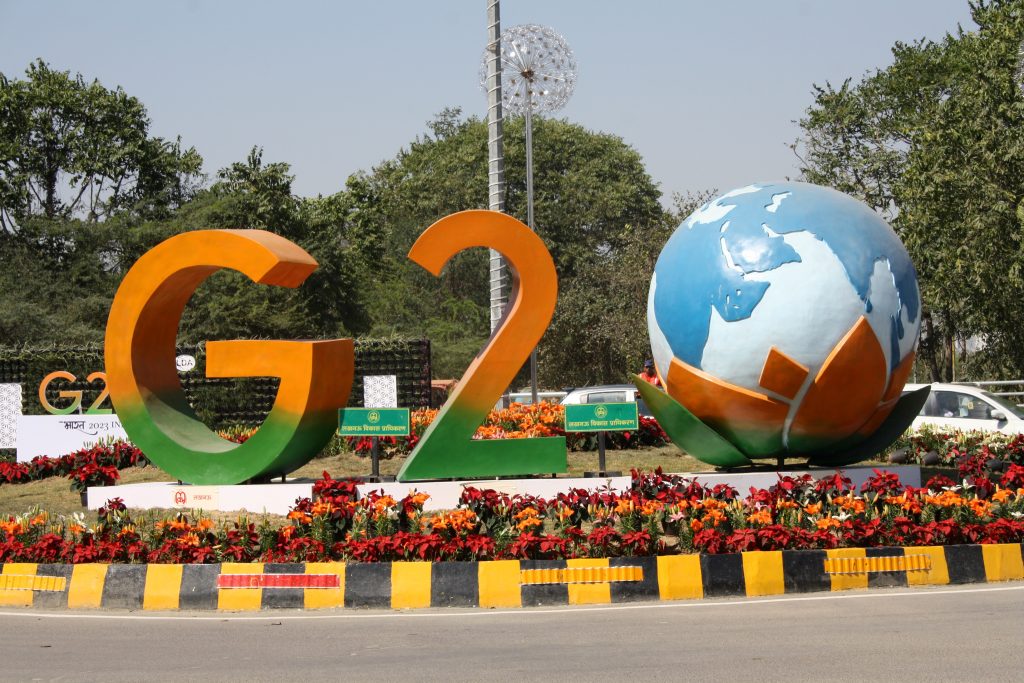India’s Global Moment? The G20 Presidency and Beyond
Despite its emphasis on strategic autonomy, India’s ties with the West have strengthened in recent years. As current G20 president, the country will host world leaders in New Delhi on September 9 and 10. How will India navigate geopolitical tensions both as G20 president and beyond?
Indian Prime Minister Narendra Modi’s visits to Western capitals have become a recurring spectacle in recent years. Notwithstanding India’s resistance to overtly condemn Russian aggression in Ukraine, Modi’s trips to the United States (US), Australia, and various European Union (EU) nations between 2022-23 reflect the elevation of India’s strategic partnerships with these countries. The country has climbed from seven out of a possible ten points in 2006 to nine points in the Bertelsmann Transformation Index’s (BTI) 2022 credibility ranking, reflecting perceptions of the nation as an “increasingly influential foreign actor.” India matters for the West for two main reasons: first, in the wider ambit of strategic rivalry with China, it is a valuable economic and security partner in the Indo-Pacific. Second, India is central to transnational issues such as climate change and emerging technologies – and cannot be overlooked. During India’s G20 presidency this year, it has stressed the need to reach solutions in a sustainable and inclusive manner. Given India’s growing global pre-eminence, what can we expect from the country as G20 president and beyond?
India’s G20 Presidency
India’s G20 presidency has a clear mission: to restore reason amidst geopolitical tensions. It aims at reminding world leaders that disagreement should not overrule the possibility of reaching consensus on transnational issues and development collaboration. Despite India’s efforts as a G20 host, meetings have been unable to escape the shadow cast by the War in Ukraine. The foreign ministers’, finance, and climate meetings did not reach a consensus. The Indian presidency has issued nine chair’s summaries after G20 meetings, instead of a common communique casting doubt over the possibility of a joint statement at the September summit. Should Ukraine be included in the draft statement, there is a strong chance that Russia and China would not agree to it – resulting in the first ever failure of the G20’s ability to issue a joint communique in its history.
Strategic Autonomy
The Indian presidency’s G20 challenges reflect its larger foreign-policy challenges. Like most countries, national interest lies at its core – with specific emphasis on its territorial integrity and economic security. While this is exemplified in Modi’s ‘India First’ rhetoric – it is rooted in the country’s postcolonial heritage, which made securing borders and economic development two of its major priorities. India’s early leaders had decided that its foreign policy would pursue an independent path that best leveraged its strengths and served its interests. Once termed non-alignment, this policy manifests as ‘strategic autonomy’, in more recent times. A key aspect of strategic autonomy is resisting taking sides in wide-ranging geopolitical contests against its will — especially when doing so compromises its interests. This is most recently seen in its response to the War in Ukraine, where it refrained from overtly condemning Russian aggression at the United Nations.
India and Russia have been long-standing partners since the Cold War. Russia is India’s largest arms supplier and they collaborate on energy, and space exploration and publicly condemning Russia would risk their historic partnership. Less than two months after the invasion, India began to boost oil imports from Russia. While at first sight, this is self-interested policy at work, two things are worth noting. First, even with these opportunistic maneuvers, India has found ways of communicating its displeasure at the turn of events in Ukraine, to Russia, such as publicly declaring to President Putin that ‘this is not an era of war’. Second, by increasing its oil imports from Russia, India has reduced its demand from other major suppliers, releasing more oil for Europe and other regions — possibly averting a potential global energy crisis.
Another feature of Indian strategic autonomy is that it enables the country to establish multiple partnerships, not just ‘allies’ and ‘enemies’. For instance, as the BTI’s 2022 country report for India notes, since 2006, India’s security links with the US have steadily increased. This is despite India’s strong ties with Russia. In the case of the other Western rival, China, India’s bilateral relations have functioned in the shadow of their disputed 3,440km border that caused a war in 1962. Since the late 80s, both countries found a way to isolate their dispute and forge an economic partnership. Notwithstanding occasional border flare ups, China and India have maintained peaceful ties.
At present, however, geopolitical tensions are exerting pressure on Indian strategic autonomy – especially vis-à-vis its relations with the major powers. War in Ukraine means that India will face challenges sourcing military supplies from Russia. Additionally, India’s delicate balancing act with China has been disrupted by deadly clashes along the disputed border since 2020. India has responded with technology sanctions on China, signaling a serious abrasion of their ties. For India, the strategic value of maintaining amicable ties with Russia and China, are eroding – suggesting similarities with Western policy on this front. Although India remains committed to strategic autonomy, it could potentially confront stark challenges, such as the possible deepening of China-Russia ties; the intensification of border tensions or the escalation of China’s military might against Taiwan. In such situations, India would be likely to lean West.
National Elections 2024
As Indian foreign policy adapts to shifting geopolitics, the country goes to vote next year, and its foreign policy maneuvers this year must also be interpreted in this context. India’s G20 presidency and Modi’s meetings with world leaders have a dual aim: to attract global attention while also appealing to the domestic electorate. While adhering to a foreign policy trajectory akin to its predecessors, the Modi government distinguishes itself by presenting these strategies with self-assured assertiveness. This approach galvanizes segments of the Indian population. At various international events, the Modi administration has depicted India as a ‘Vishwaguru’ or ‘world teacher,’ a narrative that fosters nationalistic pride by underscoring India’s cultural prowess. With the current Bharatiya Janata Party’s continued rule since 2014, the party now ranks as India’s wealthiest. It is also linked with the erosion of democratic institutions and the undermining of civil liberties – an aspect that is comprehensively explored in the 2022 BTI India report. Should the Modi government come out strong in the next election, the West will find itself facing a complex India: one that champions democracy and diversity globally, but encounters its slow decline and deterioration, locally.
First published by the Global Policy Journal’s Blog


this article was really heplful .Looking forward to more wonderful articles from you.